Analysis of Revenue Management Strategies for Hotel Performance
VerifiedAdded on 2021/05/30
|12
|2493
|66
Report
AI Summary
This report provides a comprehensive analysis of revenue management within the hotel industry. It begins by defining key metrics such as Occupancy, ADR, and RevPAR, explaining their calculations and significance. The report then delves into the performance of a specific hotel, Kobe Sheishin Orient...

Running head: REVENUE MANAGEMENT
Name of the Student
Name of the University
Author note
Name of the Student
Name of the University
Author note
Paraphrase This Document
Need a fresh take? Get an instant paraphrase of this document with our AI Paraphraser
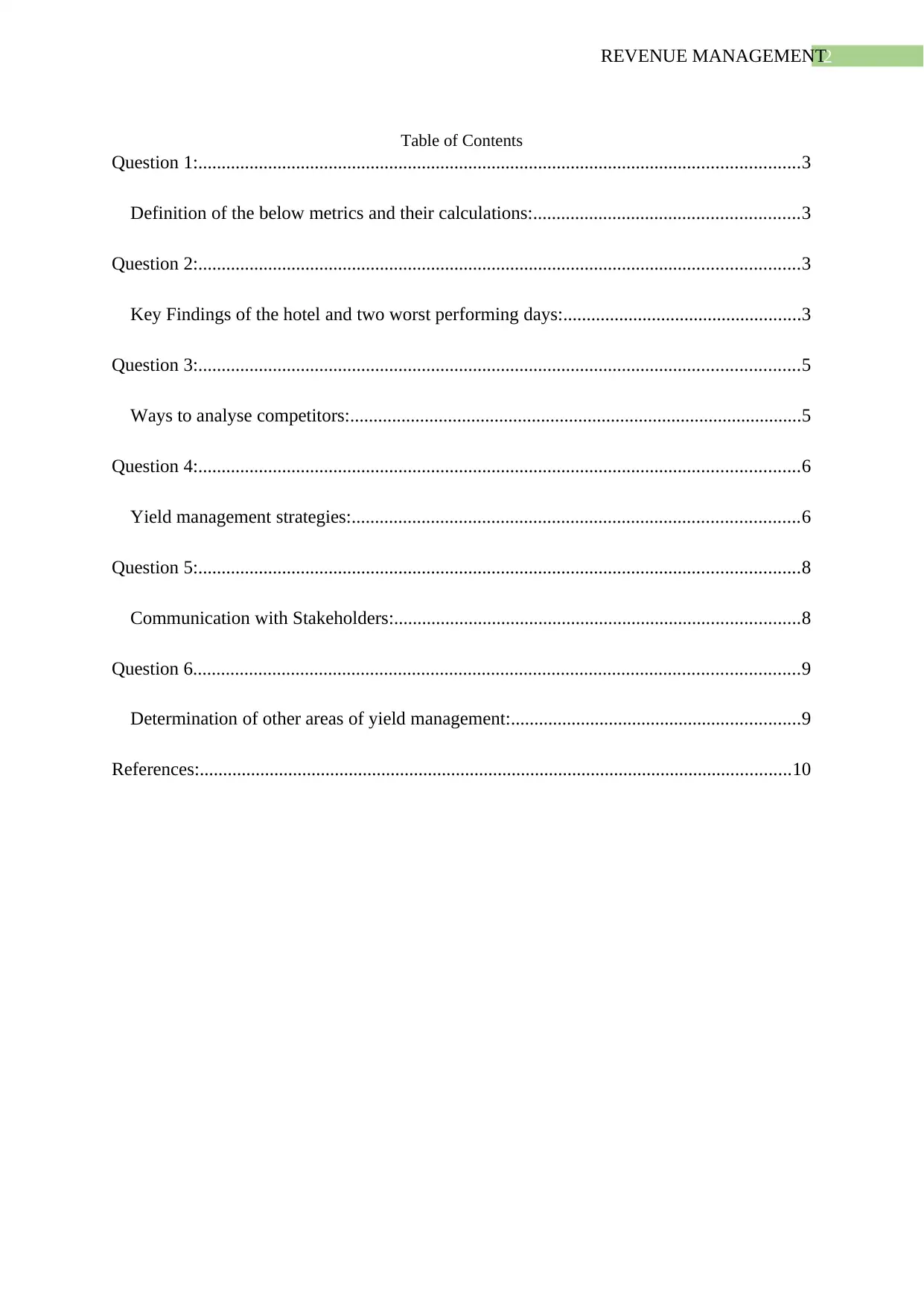
2REVENUE MANAGEMENT
Table of Contents
Question 1:.................................................................................................................................3
Definition of the below metrics and their calculations:.........................................................3
Question 2:.................................................................................................................................3
Key Findings of the hotel and two worst performing days:...................................................3
Question 3:.................................................................................................................................5
Ways to analyse competitors:.................................................................................................5
Question 4:.................................................................................................................................6
Yield management strategies:................................................................................................6
Question 5:.................................................................................................................................8
Communication with Stakeholders:.......................................................................................8
Question 6..................................................................................................................................9
Determination of other areas of yield management:..............................................................9
References:...............................................................................................................................10
Table of Contents
Question 1:.................................................................................................................................3
Definition of the below metrics and their calculations:.........................................................3
Question 2:.................................................................................................................................3
Key Findings of the hotel and two worst performing days:...................................................3
Question 3:.................................................................................................................................5
Ways to analyse competitors:.................................................................................................5
Question 4:.................................................................................................................................6
Yield management strategies:................................................................................................6
Question 5:.................................................................................................................................8
Communication with Stakeholders:.......................................................................................8
Question 6..................................................................................................................................9
Determination of other areas of yield management:..............................................................9
References:...............................................................................................................................10
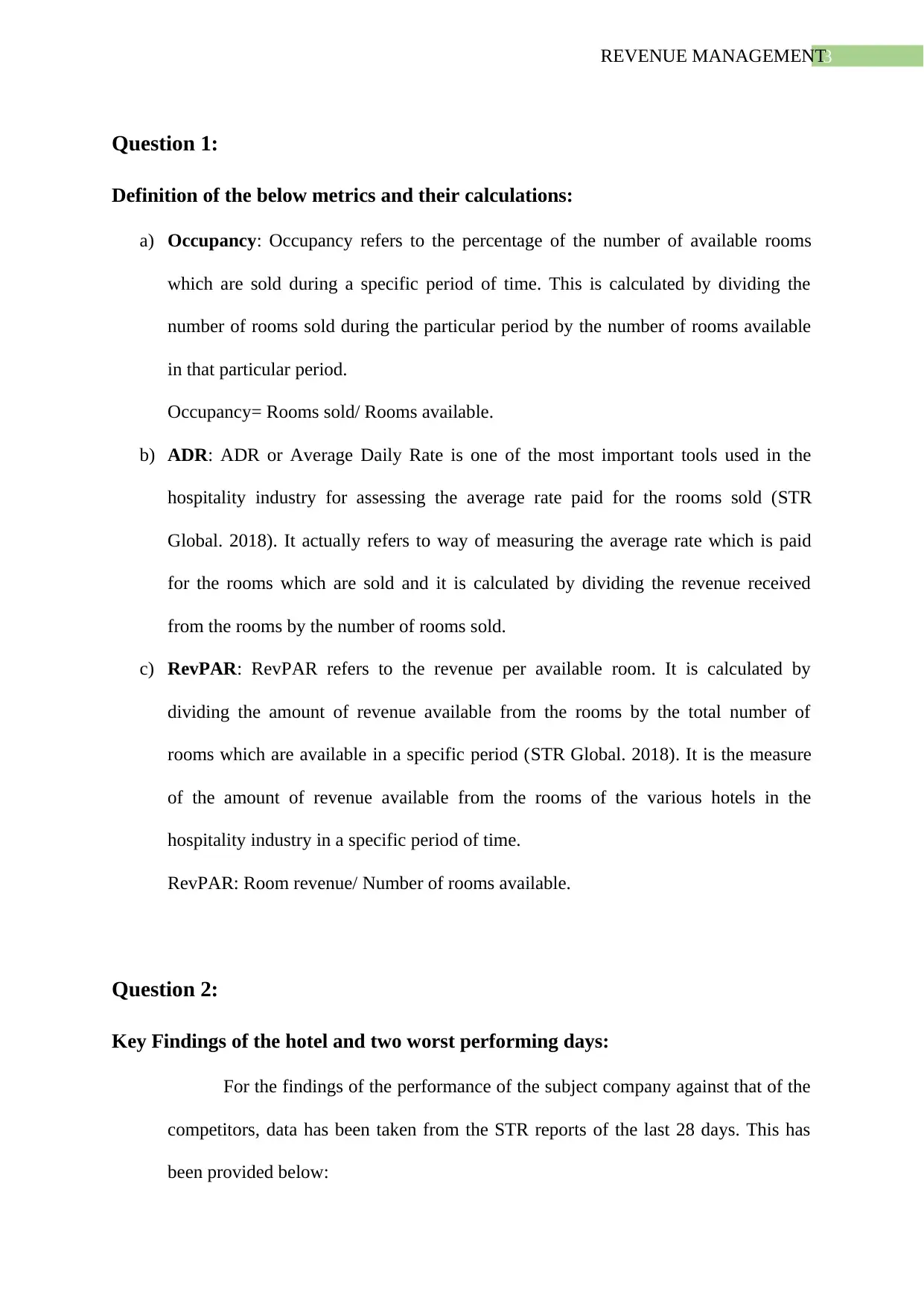
3REVENUE MANAGEMENT
Question 1:
Definition of the below metrics and their calculations:
a) Occupancy: Occupancy refers to the percentage of the number of available rooms
which are sold during a specific period of time. This is calculated by dividing the
number of rooms sold during the particular period by the number of rooms available
in that particular period.
Occupancy= Rooms sold/ Rooms available.
b) ADR: ADR or Average Daily Rate is one of the most important tools used in the
hospitality industry for assessing the average rate paid for the rooms sold (STR
Global. 2018). It actually refers to way of measuring the average rate which is paid
for the rooms which are sold and it is calculated by dividing the revenue received
from the rooms by the number of rooms sold.
c) RevPAR: RevPAR refers to the revenue per available room. It is calculated by
dividing the amount of revenue available from the rooms by the total number of
rooms which are available in a specific period (STR Global. 2018). It is the measure
of the amount of revenue available from the rooms of the various hotels in the
hospitality industry in a specific period of time.
RevPAR: Room revenue/ Number of rooms available.
Question 2:
Key Findings of the hotel and two worst performing days:
For the findings of the performance of the subject company against that of the
competitors, data has been taken from the STR reports of the last 28 days. This has
been provided below:
Question 1:
Definition of the below metrics and their calculations:
a) Occupancy: Occupancy refers to the percentage of the number of available rooms
which are sold during a specific period of time. This is calculated by dividing the
number of rooms sold during the particular period by the number of rooms available
in that particular period.
Occupancy= Rooms sold/ Rooms available.
b) ADR: ADR or Average Daily Rate is one of the most important tools used in the
hospitality industry for assessing the average rate paid for the rooms sold (STR
Global. 2018). It actually refers to way of measuring the average rate which is paid
for the rooms which are sold and it is calculated by dividing the revenue received
from the rooms by the number of rooms sold.
c) RevPAR: RevPAR refers to the revenue per available room. It is calculated by
dividing the amount of revenue available from the rooms by the total number of
rooms which are available in a specific period (STR Global. 2018). It is the measure
of the amount of revenue available from the rooms of the various hotels in the
hospitality industry in a specific period of time.
RevPAR: Room revenue/ Number of rooms available.
Question 2:
Key Findings of the hotel and two worst performing days:
For the findings of the performance of the subject company against that of the
competitors, data has been taken from the STR reports of the last 28 days. This has
been provided below:
⊘ This is a preview!⊘
Do you want full access?
Subscribe today to unlock all pages.

Trusted by 1+ million students worldwide
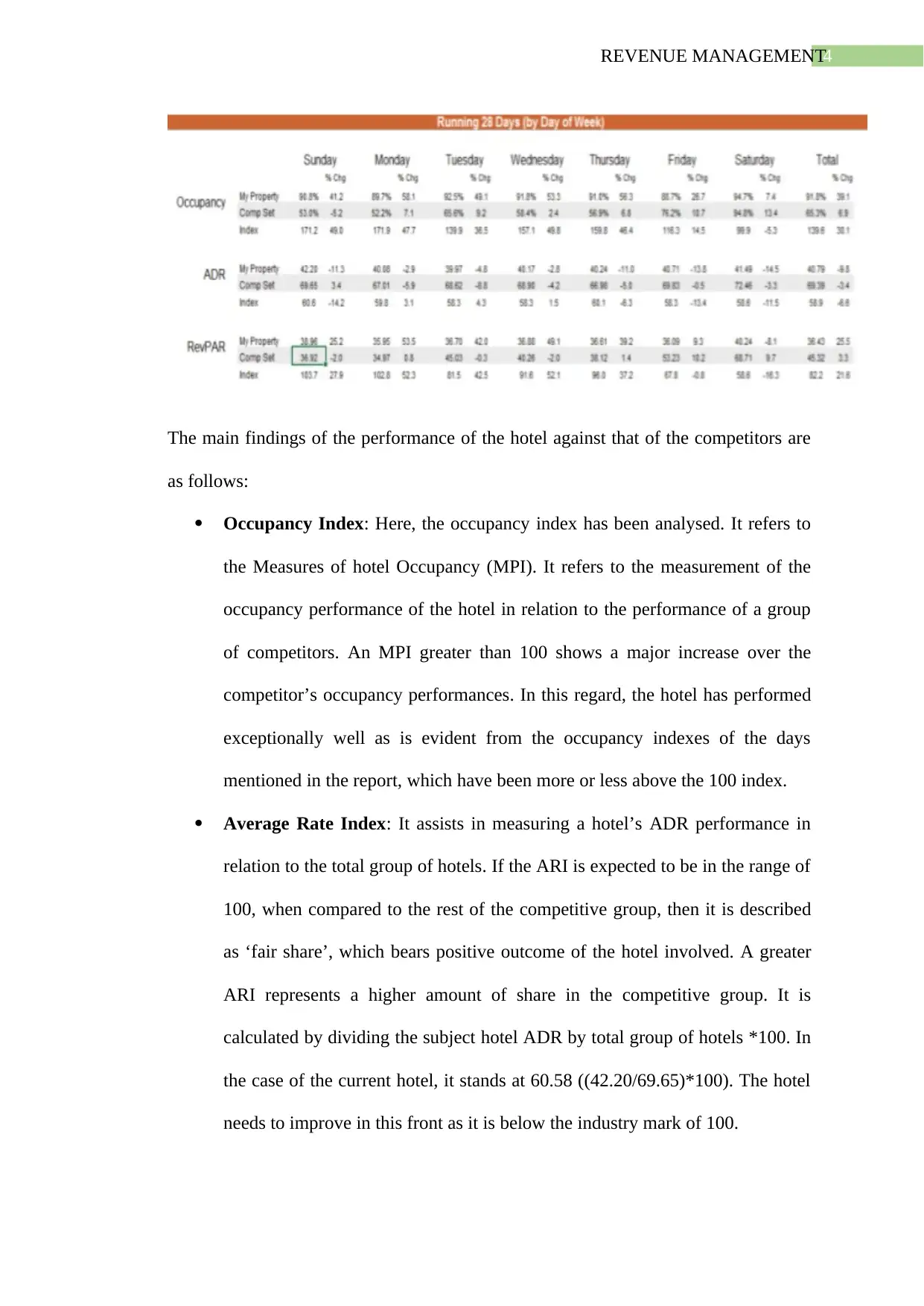
4REVENUE MANAGEMENT
The main findings of the performance of the hotel against that of the competitors are
as follows:
Occupancy Index: Here, the occupancy index has been analysed. It refers to
the Measures of hotel Occupancy (MPI). It refers to the measurement of the
occupancy performance of the hotel in relation to the performance of a group
of competitors. An MPI greater than 100 shows a major increase over the
competitor’s occupancy performances. In this regard, the hotel has performed
exceptionally well as is evident from the occupancy indexes of the days
mentioned in the report, which have been more or less above the 100 index.
Average Rate Index: It assists in measuring a hotel’s ADR performance in
relation to the total group of hotels. If the ARI is expected to be in the range of
100, when compared to the rest of the competitive group, then it is described
as ‘fair share’, which bears positive outcome of the hotel involved. A greater
ARI represents a higher amount of share in the competitive group. It is
calculated by dividing the subject hotel ADR by total group of hotels *100. In
the case of the current hotel, it stands at 60.58 ((42.20/69.65)*100). The hotel
needs to improve in this front as it is below the industry mark of 100.
The main findings of the performance of the hotel against that of the competitors are
as follows:
Occupancy Index: Here, the occupancy index has been analysed. It refers to
the Measures of hotel Occupancy (MPI). It refers to the measurement of the
occupancy performance of the hotel in relation to the performance of a group
of competitors. An MPI greater than 100 shows a major increase over the
competitor’s occupancy performances. In this regard, the hotel has performed
exceptionally well as is evident from the occupancy indexes of the days
mentioned in the report, which have been more or less above the 100 index.
Average Rate Index: It assists in measuring a hotel’s ADR performance in
relation to the total group of hotels. If the ARI is expected to be in the range of
100, when compared to the rest of the competitive group, then it is described
as ‘fair share’, which bears positive outcome of the hotel involved. A greater
ARI represents a higher amount of share in the competitive group. It is
calculated by dividing the subject hotel ADR by total group of hotels *100. In
the case of the current hotel, it stands at 60.58 ((42.20/69.65)*100). The hotel
needs to improve in this front as it is below the industry mark of 100.
Paraphrase This Document
Need a fresh take? Get an instant paraphrase of this document with our AI Paraphraser
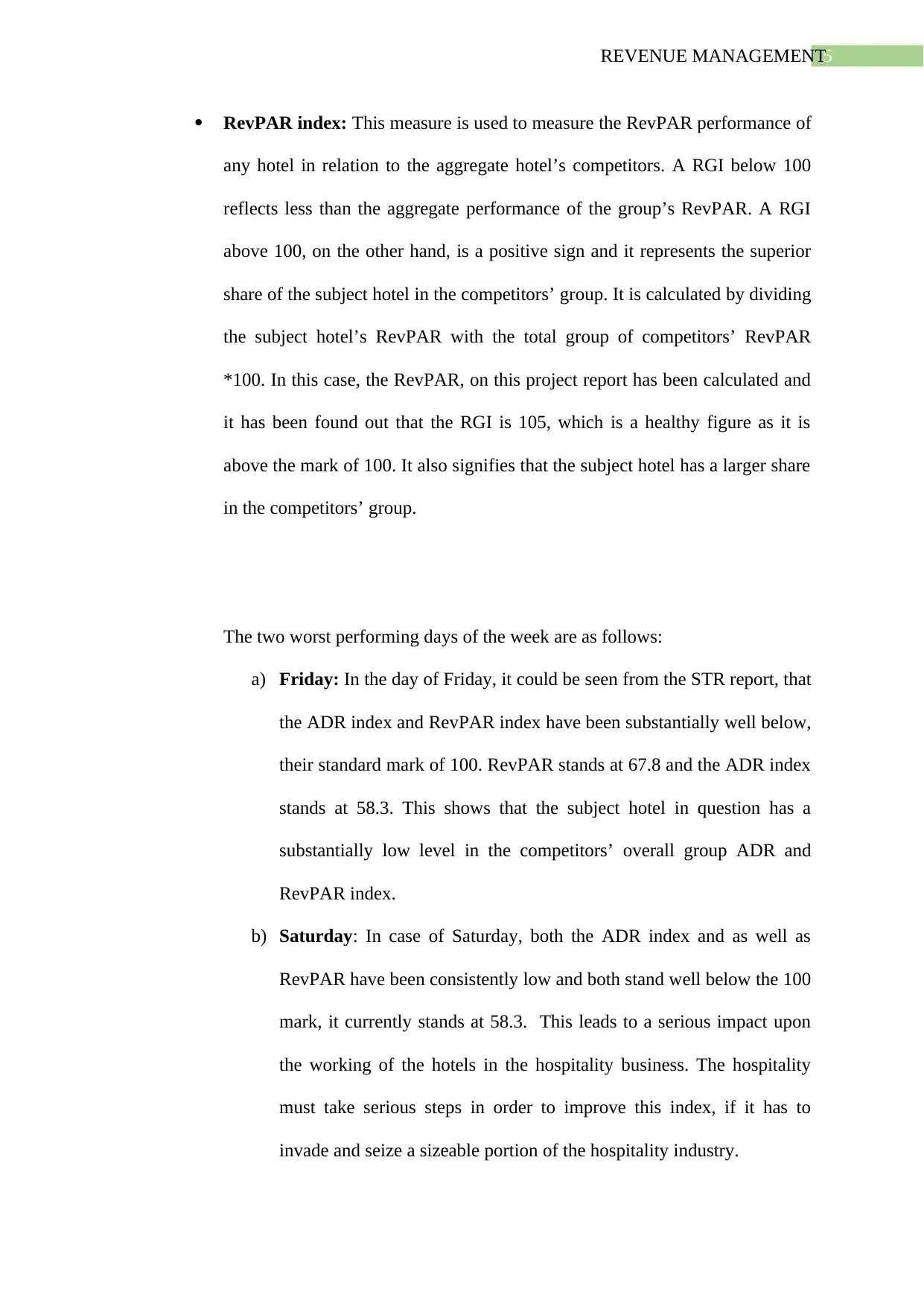
5REVENUE MANAGEMENT
RevPAR index: This measure is used to measure the RevPAR performance of
any hotel in relation to the aggregate hotel’s competitors. A RGI below 100
reflects less than the aggregate performance of the group’s RevPAR. A RGI
above 100, on the other hand, is a positive sign and it represents the superior
share of the subject hotel in the competitors’ group. It is calculated by dividing
the subject hotel’s RevPAR with the total group of competitors’ RevPAR
*100. In this case, the RevPAR, on this project report has been calculated and
it has been found out that the RGI is 105, which is a healthy figure as it is
above the mark of 100. It also signifies that the subject hotel has a larger share
in the competitors’ group.
The two worst performing days of the week are as follows:
a) Friday: In the day of Friday, it could be seen from the STR report, that
the ADR index and RevPAR index have been substantially well below,
their standard mark of 100. RevPAR stands at 67.8 and the ADR index
stands at 58.3. This shows that the subject hotel in question has a
substantially low level in the competitors’ overall group ADR and
RevPAR index.
b) Saturday: In case of Saturday, both the ADR index and as well as
RevPAR have been consistently low and both stand well below the 100
mark, it currently stands at 58.3. This leads to a serious impact upon
the working of the hotels in the hospitality business. The hospitality
must take serious steps in order to improve this index, if it has to
invade and seize a sizeable portion of the hospitality industry.
RevPAR index: This measure is used to measure the RevPAR performance of
any hotel in relation to the aggregate hotel’s competitors. A RGI below 100
reflects less than the aggregate performance of the group’s RevPAR. A RGI
above 100, on the other hand, is a positive sign and it represents the superior
share of the subject hotel in the competitors’ group. It is calculated by dividing
the subject hotel’s RevPAR with the total group of competitors’ RevPAR
*100. In this case, the RevPAR, on this project report has been calculated and
it has been found out that the RGI is 105, which is a healthy figure as it is
above the mark of 100. It also signifies that the subject hotel has a larger share
in the competitors’ group.
The two worst performing days of the week are as follows:
a) Friday: In the day of Friday, it could be seen from the STR report, that
the ADR index and RevPAR index have been substantially well below,
their standard mark of 100. RevPAR stands at 67.8 and the ADR index
stands at 58.3. This shows that the subject hotel in question has a
substantially low level in the competitors’ overall group ADR and
RevPAR index.
b) Saturday: In case of Saturday, both the ADR index and as well as
RevPAR have been consistently low and both stand well below the 100
mark, it currently stands at 58.3. This leads to a serious impact upon
the working of the hotels in the hospitality business. The hospitality
must take serious steps in order to improve this index, if it has to
invade and seize a sizeable portion of the hospitality industry.
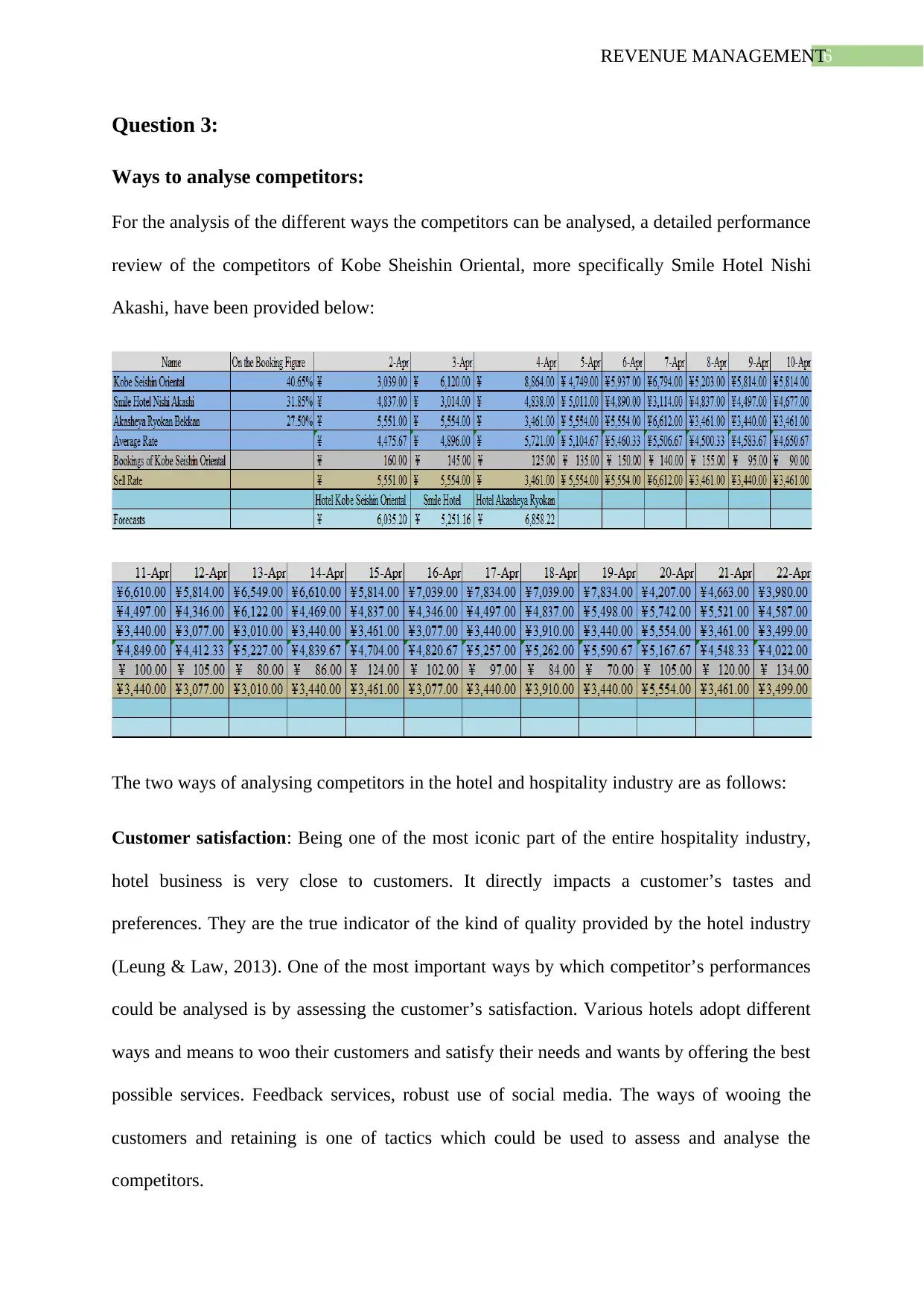
6REVENUE MANAGEMENT
Question 3:
Ways to analyse competitors:
For the analysis of the different ways the competitors can be analysed, a detailed performance
review of the competitors of Kobe Sheishin Oriental, more specifically Smile Hotel Nishi
Akashi, have been provided below:
The two ways of analysing competitors in the hotel and hospitality industry are as follows:
Customer satisfaction: Being one of the most iconic part of the entire hospitality industry,
hotel business is very close to customers. It directly impacts a customer’s tastes and
preferences. They are the true indicator of the kind of quality provided by the hotel industry
(Leung & Law, 2013). One of the most important ways by which competitor’s performances
could be analysed is by assessing the customer’s satisfaction. Various hotels adopt different
ways and means to woo their customers and satisfy their needs and wants by offering the best
possible services. Feedback services, robust use of social media. The ways of wooing the
customers and retaining is one of tactics which could be used to assess and analyse the
competitors.
Question 3:
Ways to analyse competitors:
For the analysis of the different ways the competitors can be analysed, a detailed performance
review of the competitors of Kobe Sheishin Oriental, more specifically Smile Hotel Nishi
Akashi, have been provided below:
The two ways of analysing competitors in the hotel and hospitality industry are as follows:
Customer satisfaction: Being one of the most iconic part of the entire hospitality industry,
hotel business is very close to customers. It directly impacts a customer’s tastes and
preferences. They are the true indicator of the kind of quality provided by the hotel industry
(Leung & Law, 2013). One of the most important ways by which competitor’s performances
could be analysed is by assessing the customer’s satisfaction. Various hotels adopt different
ways and means to woo their customers and satisfy their needs and wants by offering the best
possible services. Feedback services, robust use of social media. The ways of wooing the
customers and retaining is one of tactics which could be used to assess and analyse the
competitors.
⊘ This is a preview!⊘
Do you want full access?
Subscribe today to unlock all pages.

Trusted by 1+ million students worldwide
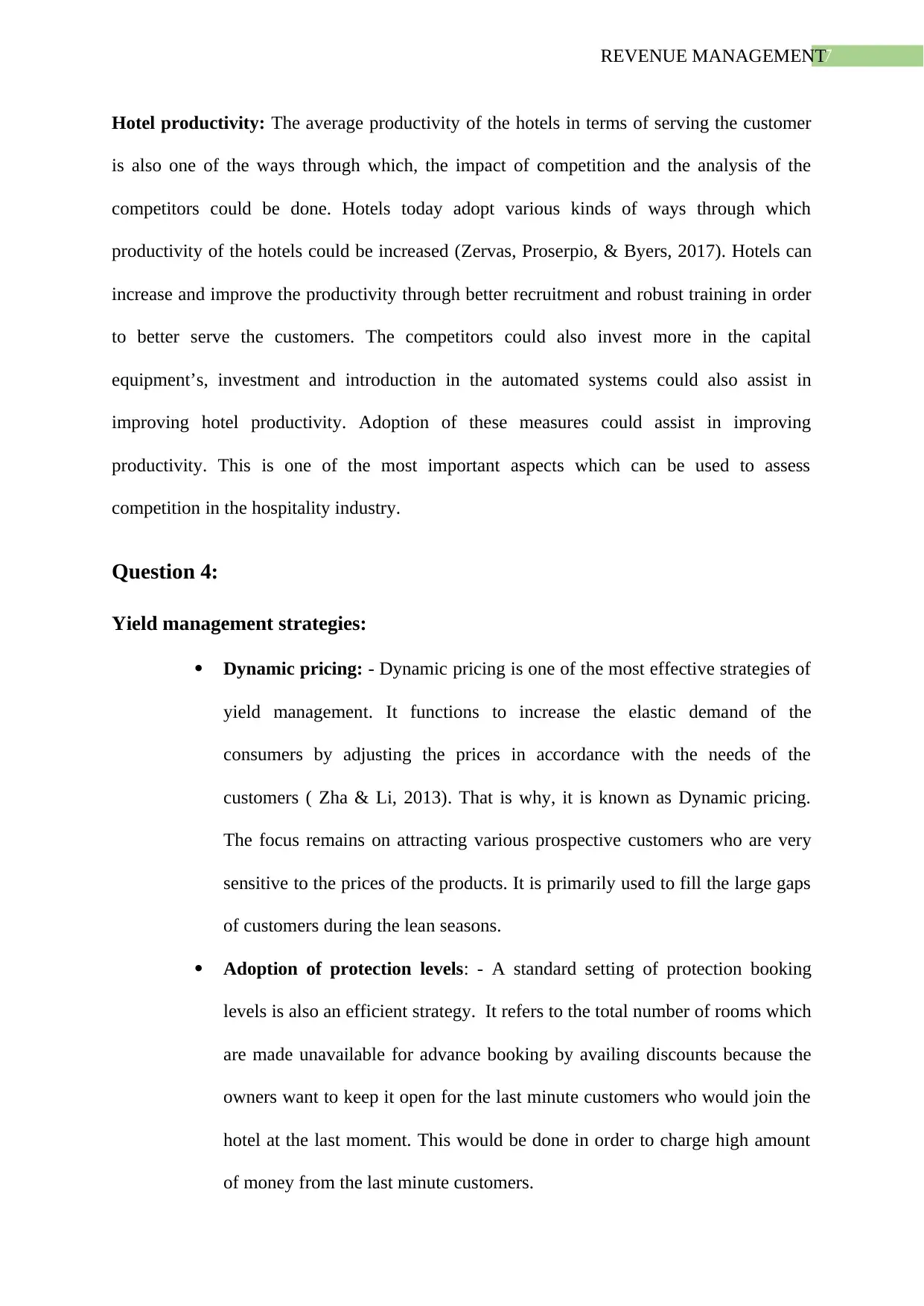
7REVENUE MANAGEMENT
Hotel productivity: The average productivity of the hotels in terms of serving the customer
is also one of the ways through which, the impact of competition and the analysis of the
competitors could be done. Hotels today adopt various kinds of ways through which
productivity of the hotels could be increased (Zervas, Proserpio, & Byers, 2017). Hotels can
increase and improve the productivity through better recruitment and robust training in order
to better serve the customers. The competitors could also invest more in the capital
equipment’s, investment and introduction in the automated systems could also assist in
improving hotel productivity. Adoption of these measures could assist in improving
productivity. This is one of the most important aspects which can be used to assess
competition in the hospitality industry.
Question 4:
Yield management strategies:
Dynamic pricing: - Dynamic pricing is one of the most effective strategies of
yield management. It functions to increase the elastic demand of the
consumers by adjusting the prices in accordance with the needs of the
customers ( Zha & Li, 2013). That is why, it is known as Dynamic pricing.
The focus remains on attracting various prospective customers who are very
sensitive to the prices of the products. It is primarily used to fill the large gaps
of customers during the lean seasons.
Adoption of protection levels: - A standard setting of protection booking
levels is also an efficient strategy. It refers to the total number of rooms which
are made unavailable for advance booking by availing discounts because the
owners want to keep it open for the last minute customers who would join the
hotel at the last moment. This would be done in order to charge high amount
of money from the last minute customers.
Hotel productivity: The average productivity of the hotels in terms of serving the customer
is also one of the ways through which, the impact of competition and the analysis of the
competitors could be done. Hotels today adopt various kinds of ways through which
productivity of the hotels could be increased (Zervas, Proserpio, & Byers, 2017). Hotels can
increase and improve the productivity through better recruitment and robust training in order
to better serve the customers. The competitors could also invest more in the capital
equipment’s, investment and introduction in the automated systems could also assist in
improving hotel productivity. Adoption of these measures could assist in improving
productivity. This is one of the most important aspects which can be used to assess
competition in the hospitality industry.
Question 4:
Yield management strategies:
Dynamic pricing: - Dynamic pricing is one of the most effective strategies of
yield management. It functions to increase the elastic demand of the
consumers by adjusting the prices in accordance with the needs of the
customers ( Zha & Li, 2013). That is why, it is known as Dynamic pricing.
The focus remains on attracting various prospective customers who are very
sensitive to the prices of the products. It is primarily used to fill the large gaps
of customers during the lean seasons.
Adoption of protection levels: - A standard setting of protection booking
levels is also an efficient strategy. It refers to the total number of rooms which
are made unavailable for advance booking by availing discounts because the
owners want to keep it open for the last minute customers who would join the
hotel at the last moment. This would be done in order to charge high amount
of money from the last minute customers.
Paraphrase This Document
Need a fresh take? Get an instant paraphrase of this document with our AI Paraphraser

8REVENUE MANAGEMENT
Inelastic vs. elastic demand technique: - Striking a proper balance between
the inelastic and elastic demand is one of the key ingredients of yield
management. Inelastic demand refers to the total number of room reservations
any hotel could expect as a result of being in business. This is because the
location and the market image of the hotel often ascertains the degree of
inelastic demand. For example, a clean and proper hotel located close to an
airport can frequently expect inelastic demand to be higher than one of lesser
quality located in some other part of the city. Whereas, elastic demand refers
to the demand that is created from promotional and pricing strategies. Yield
management techniques are thus very important for creating a proper balance
between inelastic and elastic demand.
Overbooking: It is one of the most clever and precise yield management
strategies. It increases revenue generation, but can negatively affect a hotel’s
reputation. Overbooking is based on the premise that a certain percentage of
customers will reserve a room and not show up. Rather than simply submitting
to the potential loss of revenue, the hotel would book more rooms than
actually are actually available.
Pricing strategy of middle market: In this pricing strategy, the hotel owner
would price their expensive rooms at the same rate as basic rooms that are
available at competitors’ hotels. This allows the subject hotel to grab the
attention of the middle class customers who are looking for a competitive
priced hotel.
Inelastic vs. elastic demand technique: - Striking a proper balance between
the inelastic and elastic demand is one of the key ingredients of yield
management. Inelastic demand refers to the total number of room reservations
any hotel could expect as a result of being in business. This is because the
location and the market image of the hotel often ascertains the degree of
inelastic demand. For example, a clean and proper hotel located close to an
airport can frequently expect inelastic demand to be higher than one of lesser
quality located in some other part of the city. Whereas, elastic demand refers
to the demand that is created from promotional and pricing strategies. Yield
management techniques are thus very important for creating a proper balance
between inelastic and elastic demand.
Overbooking: It is one of the most clever and precise yield management
strategies. It increases revenue generation, but can negatively affect a hotel’s
reputation. Overbooking is based on the premise that a certain percentage of
customers will reserve a room and not show up. Rather than simply submitting
to the potential loss of revenue, the hotel would book more rooms than
actually are actually available.
Pricing strategy of middle market: In this pricing strategy, the hotel owner
would price their expensive rooms at the same rate as basic rooms that are
available at competitors’ hotels. This allows the subject hotel to grab the
attention of the middle class customers who are looking for a competitive
priced hotel.
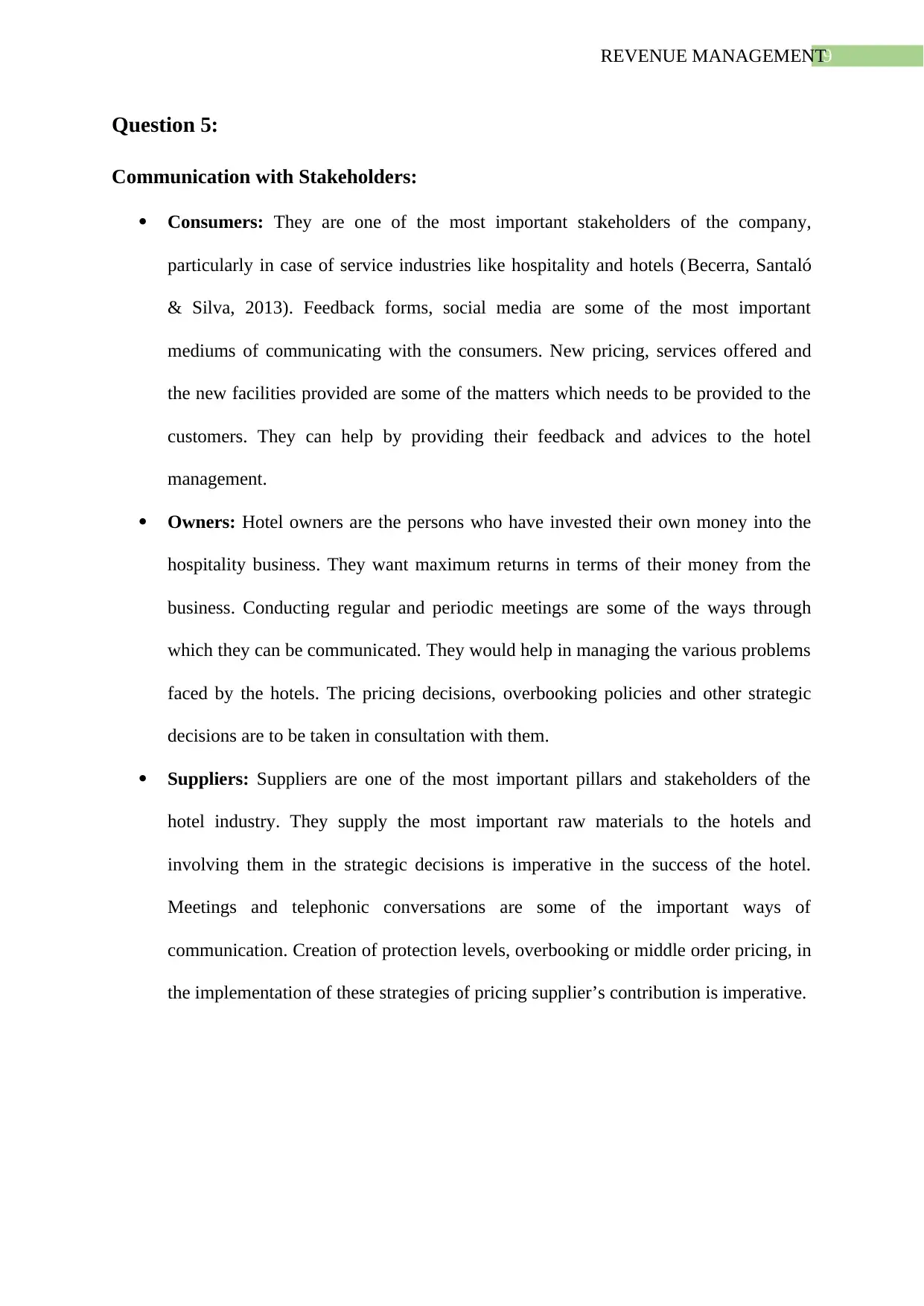
9REVENUE MANAGEMENT
Question 5:
Communication with Stakeholders:
Consumers: They are one of the most important stakeholders of the company,
particularly in case of service industries like hospitality and hotels (Becerra, Santaló
& Silva, 2013). Feedback forms, social media are some of the most important
mediums of communicating with the consumers. New pricing, services offered and
the new facilities provided are some of the matters which needs to be provided to the
customers. They can help by providing their feedback and advices to the hotel
management.
Owners: Hotel owners are the persons who have invested their own money into the
hospitality business. They want maximum returns in terms of their money from the
business. Conducting regular and periodic meetings are some of the ways through
which they can be communicated. They would help in managing the various problems
faced by the hotels. The pricing decisions, overbooking policies and other strategic
decisions are to be taken in consultation with them.
Suppliers: Suppliers are one of the most important pillars and stakeholders of the
hotel industry. They supply the most important raw materials to the hotels and
involving them in the strategic decisions is imperative in the success of the hotel.
Meetings and telephonic conversations are some of the important ways of
communication. Creation of protection levels, overbooking or middle order pricing, in
the implementation of these strategies of pricing supplier’s contribution is imperative.
Question 5:
Communication with Stakeholders:
Consumers: They are one of the most important stakeholders of the company,
particularly in case of service industries like hospitality and hotels (Becerra, Santaló
& Silva, 2013). Feedback forms, social media are some of the most important
mediums of communicating with the consumers. New pricing, services offered and
the new facilities provided are some of the matters which needs to be provided to the
customers. They can help by providing their feedback and advices to the hotel
management.
Owners: Hotel owners are the persons who have invested their own money into the
hospitality business. They want maximum returns in terms of their money from the
business. Conducting regular and periodic meetings are some of the ways through
which they can be communicated. They would help in managing the various problems
faced by the hotels. The pricing decisions, overbooking policies and other strategic
decisions are to be taken in consultation with them.
Suppliers: Suppliers are one of the most important pillars and stakeholders of the
hotel industry. They supply the most important raw materials to the hotels and
involving them in the strategic decisions is imperative in the success of the hotel.
Meetings and telephonic conversations are some of the important ways of
communication. Creation of protection levels, overbooking or middle order pricing, in
the implementation of these strategies of pricing supplier’s contribution is imperative.
⊘ This is a preview!⊘
Do you want full access?
Subscribe today to unlock all pages.

Trusted by 1+ million students worldwide
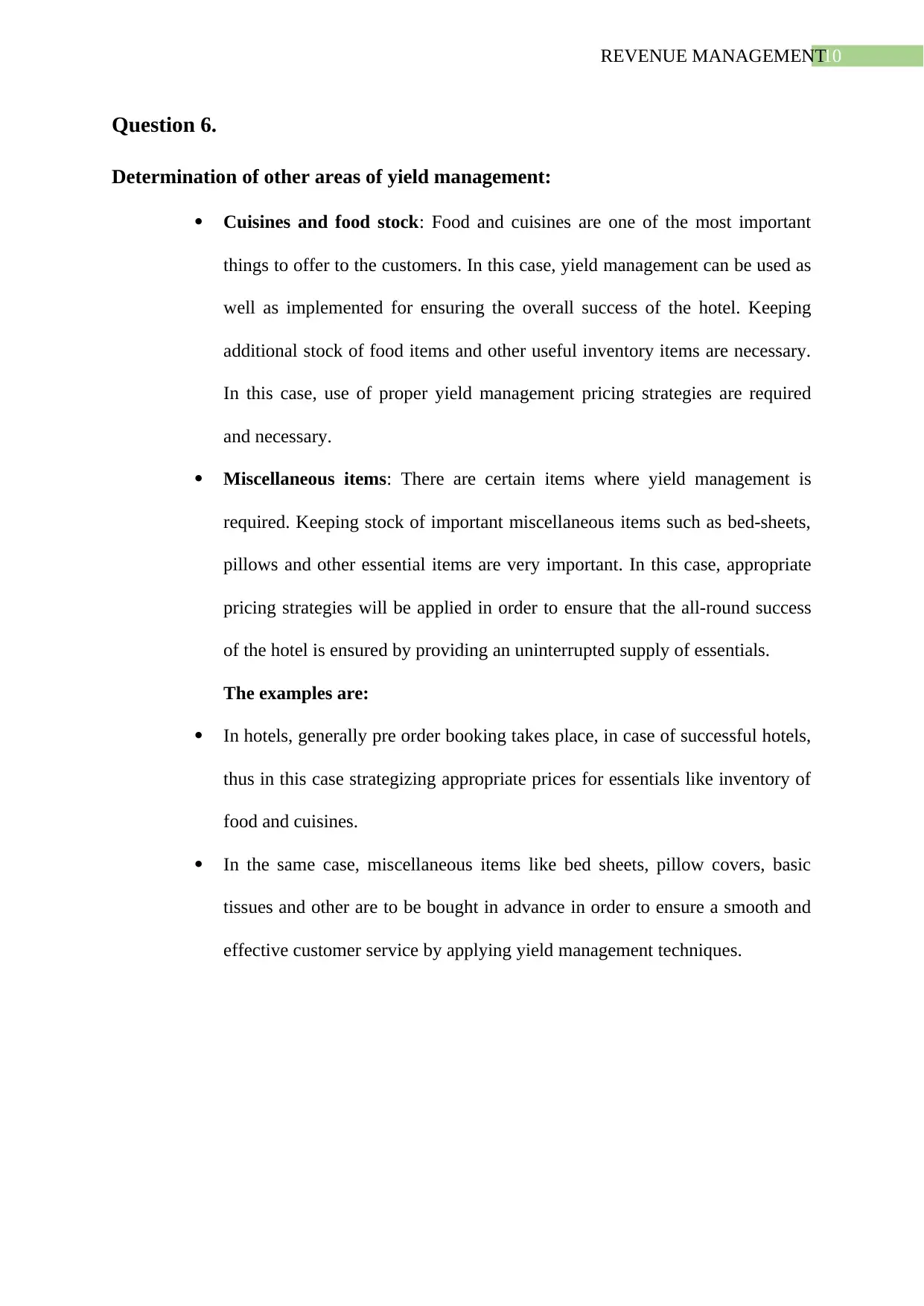
10REVENUE MANAGEMENT
Question 6.
Determination of other areas of yield management:
Cuisines and food stock: Food and cuisines are one of the most important
things to offer to the customers. In this case, yield management can be used as
well as implemented for ensuring the overall success of the hotel. Keeping
additional stock of food items and other useful inventory items are necessary.
In this case, use of proper yield management pricing strategies are required
and necessary.
Miscellaneous items: There are certain items where yield management is
required. Keeping stock of important miscellaneous items such as bed-sheets,
pillows and other essential items are very important. In this case, appropriate
pricing strategies will be applied in order to ensure that the all-round success
of the hotel is ensured by providing an uninterrupted supply of essentials.
The examples are:
In hotels, generally pre order booking takes place, in case of successful hotels,
thus in this case strategizing appropriate prices for essentials like inventory of
food and cuisines.
In the same case, miscellaneous items like bed sheets, pillow covers, basic
tissues and other are to be bought in advance in order to ensure a smooth and
effective customer service by applying yield management techniques.
Question 6.
Determination of other areas of yield management:
Cuisines and food stock: Food and cuisines are one of the most important
things to offer to the customers. In this case, yield management can be used as
well as implemented for ensuring the overall success of the hotel. Keeping
additional stock of food items and other useful inventory items are necessary.
In this case, use of proper yield management pricing strategies are required
and necessary.
Miscellaneous items: There are certain items where yield management is
required. Keeping stock of important miscellaneous items such as bed-sheets,
pillows and other essential items are very important. In this case, appropriate
pricing strategies will be applied in order to ensure that the all-round success
of the hotel is ensured by providing an uninterrupted supply of essentials.
The examples are:
In hotels, generally pre order booking takes place, in case of successful hotels,
thus in this case strategizing appropriate prices for essentials like inventory of
food and cuisines.
In the same case, miscellaneous items like bed sheets, pillow covers, basic
tissues and other are to be bought in advance in order to ensure a smooth and
effective customer service by applying yield management techniques.
Paraphrase This Document
Need a fresh take? Get an instant paraphrase of this document with our AI Paraphraser
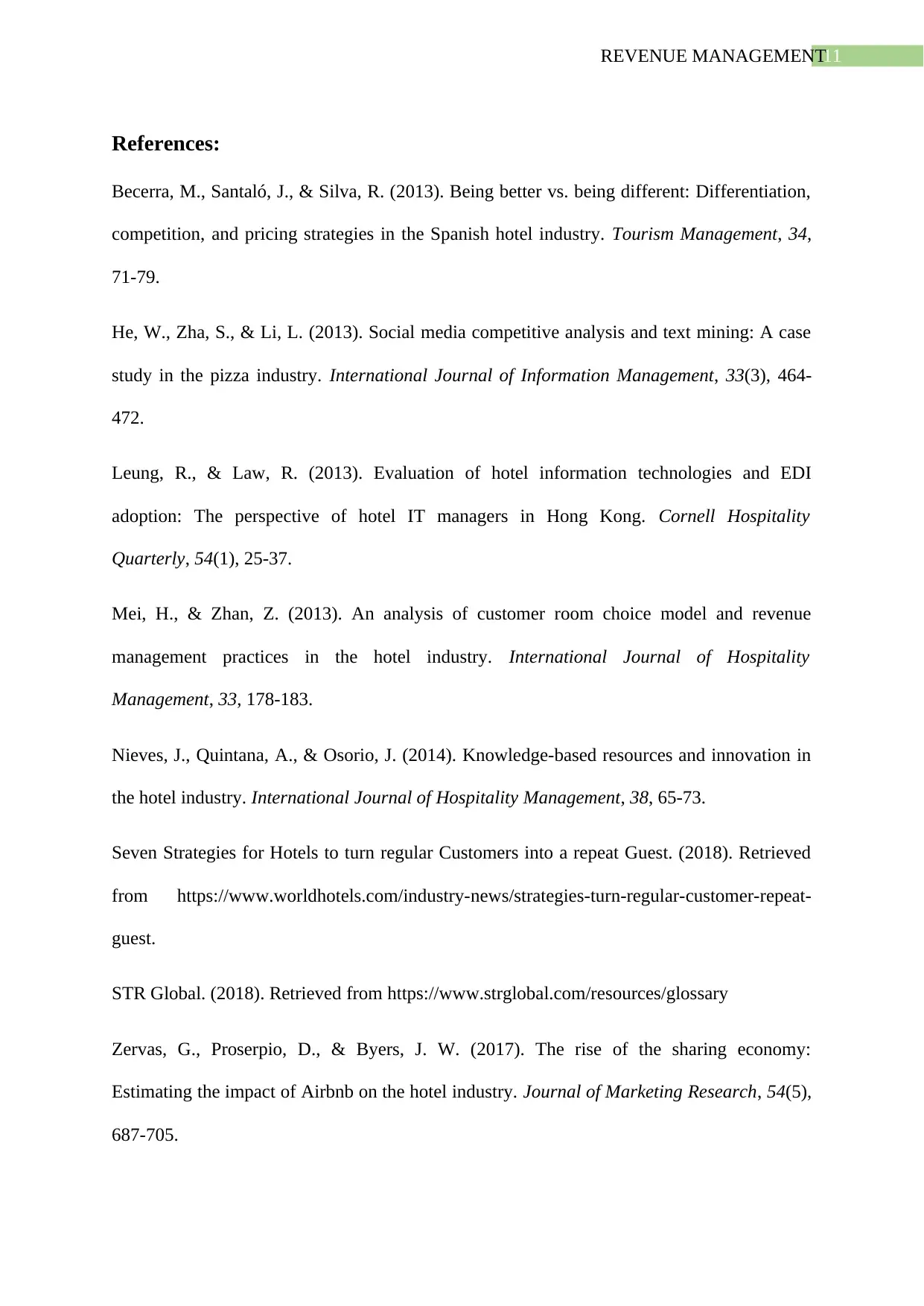
11REVENUE MANAGEMENT
References:
Becerra, M., Santaló, J., & Silva, R. (2013). Being better vs. being different: Differentiation,
competition, and pricing strategies in the Spanish hotel industry. Tourism Management, 34,
71-79.
He, W., Zha, S., & Li, L. (2013). Social media competitive analysis and text mining: A case
study in the pizza industry. International Journal of Information Management, 33(3), 464-
472.
Leung, R., & Law, R. (2013). Evaluation of hotel information technologies and EDI
adoption: The perspective of hotel IT managers in Hong Kong. Cornell Hospitality
Quarterly, 54(1), 25-37.
Mei, H., & Zhan, Z. (2013). An analysis of customer room choice model and revenue
management practices in the hotel industry. International Journal of Hospitality
Management, 33, 178-183.
Nieves, J., Quintana, A., & Osorio, J. (2014). Knowledge-based resources and innovation in
the hotel industry. International Journal of Hospitality Management, 38, 65-73.
Seven Strategies for Hotels to turn regular Customers into a repeat Guest. (2018). Retrieved
from https://www.worldhotels.com/industry-news/strategies-turn-regular-customer-repeat-
guest.
STR Global. (2018). Retrieved from https://www.strglobal.com/resources/glossary
Zervas, G., Proserpio, D., & Byers, J. W. (2017). The rise of the sharing economy:
Estimating the impact of Airbnb on the hotel industry. Journal of Marketing Research, 54(5),
687-705.
References:
Becerra, M., Santaló, J., & Silva, R. (2013). Being better vs. being different: Differentiation,
competition, and pricing strategies in the Spanish hotel industry. Tourism Management, 34,
71-79.
He, W., Zha, S., & Li, L. (2013). Social media competitive analysis and text mining: A case
study in the pizza industry. International Journal of Information Management, 33(3), 464-
472.
Leung, R., & Law, R. (2013). Evaluation of hotel information technologies and EDI
adoption: The perspective of hotel IT managers in Hong Kong. Cornell Hospitality
Quarterly, 54(1), 25-37.
Mei, H., & Zhan, Z. (2013). An analysis of customer room choice model and revenue
management practices in the hotel industry. International Journal of Hospitality
Management, 33, 178-183.
Nieves, J., Quintana, A., & Osorio, J. (2014). Knowledge-based resources and innovation in
the hotel industry. International Journal of Hospitality Management, 38, 65-73.
Seven Strategies for Hotels to turn regular Customers into a repeat Guest. (2018). Retrieved
from https://www.worldhotels.com/industry-news/strategies-turn-regular-customer-repeat-
guest.
STR Global. (2018). Retrieved from https://www.strglobal.com/resources/glossary
Zervas, G., Proserpio, D., & Byers, J. W. (2017). The rise of the sharing economy:
Estimating the impact of Airbnb on the hotel industry. Journal of Marketing Research, 54(5),
687-705.
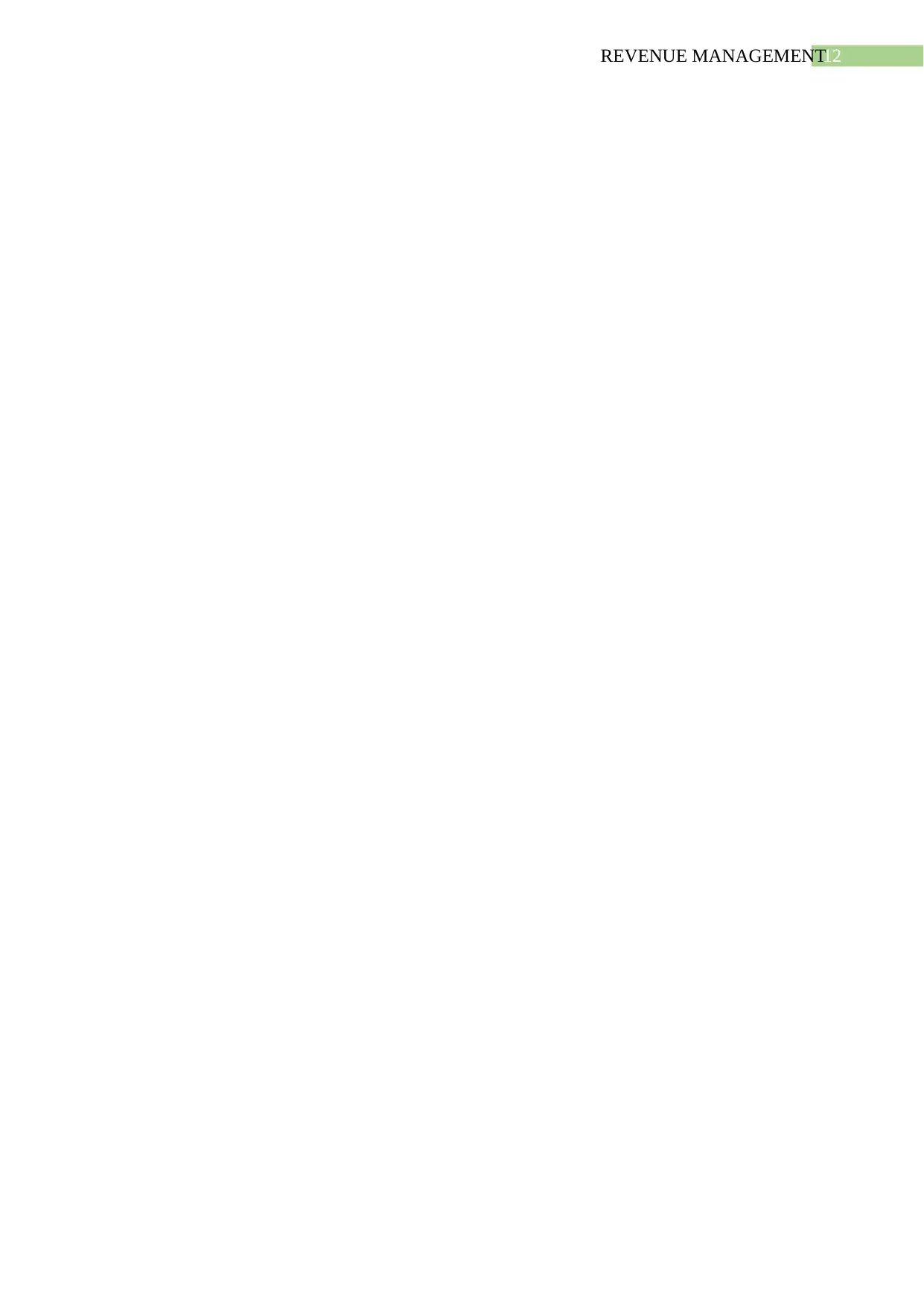
12REVENUE MANAGEMENT
⊘ This is a preview!⊘
Do you want full access?
Subscribe today to unlock all pages.

Trusted by 1+ million students worldwide
1 out of 12
Related Documents
Your All-in-One AI-Powered Toolkit for Academic Success.
+13062052269
info@desklib.com
Available 24*7 on WhatsApp / Email
![[object Object]](/_next/static/media/star-bottom.7253800d.svg)
Unlock your academic potential
© 2024 | Zucol Services PVT LTD | All rights reserved.





